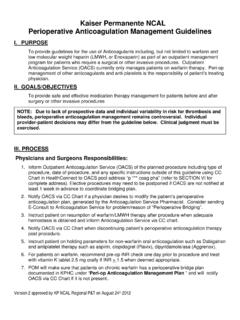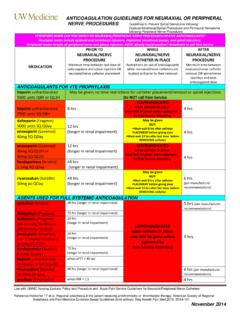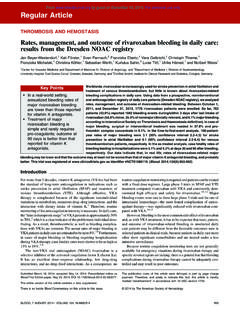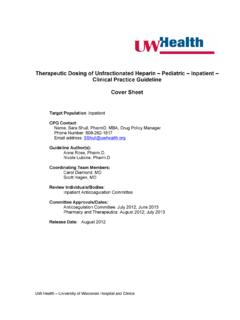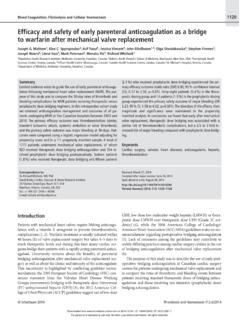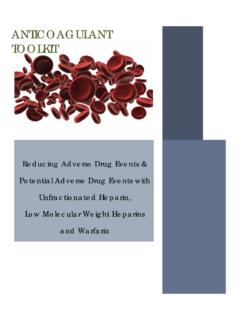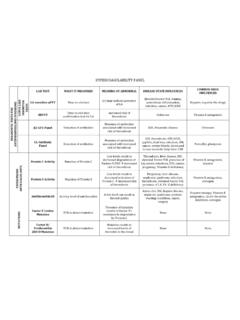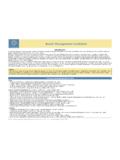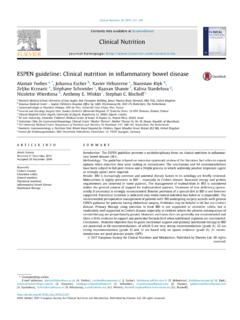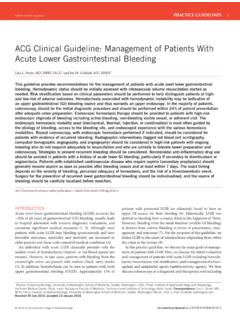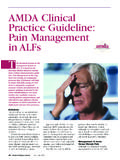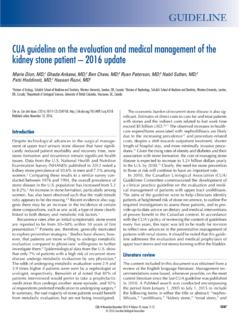Transcription of GUIDELINE for PERIOPERATIVE MANAGEMENT OF …
1 GUIDELINE for PERIOPERATIVE MANAGEMENT OF antithrombotic therapy . This document is intended as a GUIDELINE only and should not replace sound clinical judgment Bridging therapy is a complex process that usually requires expert level review. Consultation with a provider with significant experience in this area such as a benign hematologist, outpatient anticoagulation clinic or inpatient anticoagulation service is strongly recommended. Inpatient anticoagulation service 505-264-6970 Outpatient Coumadin Clinic 505-272-6202. Most of these CHEST 2012 recommendations are WEAK ( 2C) because they are based on little or no high-quality evidence.
2 Therefore, while we hope they will serve as a useful starting point, it is anticipated that clinical practice will deviate from these suggestions in many instances and these suggestions should never supercede the judgment of an experienced clinician who is best positioned to evaluate the risks and benefits of different strategies for an individual patient. Note: Peri-operative bridging is different from induction of anticoagulation for an acute thrombotic event. When bridging, it is not necessary to complete 5 full days of overlap therapy with warfarin and parenteral anticoagulant, as it is for an acute thrombotic event.
3 The bridge may be discontinued once the INR is >2 even if that occurs before day 5. I. Assessment of need for bridging versus no bridging in MAJOR procedures A. PERIOPERATIVE MANAGEMENT is assessed based on the risk of bleeding and risk of thromboembolism B. Recommendations for PERIOPERATIVE bridging are outlined below based on the most common indications for warfarin therapy and risk stratification for PERIOPERATIVE thrombosis RISK. STRATUM MECHANICAL HEART VALVE ATRIAL FIBRILLATION VTE RECOMMEND. High* - Any mitral valve prosthesis - CHADS2 of 5 or 6 - Recent VTE (within 3 mo) Suggest (>10% annual - Any caged-ball or tilting disc - Recent stroke or - Severe thrombophilia: bridging risk of aortic valve prosthesis TIA (within 3 mo) Protein C, protein S, or (Grade 2C).)
4 Thrombo- embolism (TE)) - Recent stroke or TIA (within 6 - Rheumatic valvular antithrombin deficiency mo) heart disease Antiphospholipid antibodies Multiple abnormalities Moderate Bileaflet aortic valve prosthesis CHADS2 of 3 or 4 - VTE within the past 3-12 mo Assess need for (5-10% annual and one or more risk factors: - Non-severe thrombophilia: bridging based risk of TE). - Atrial fibrillation Heterozygous factor V Leiden on patient- - Prior stroke or TIA Prothrombin gene mutation specific and - Hypertension - Recurrent VTE surgery related - Diabetes - Active cancer (treated within 6 factors (see - Congestive heart failure mo or palliative) section D.
5 - Age> 75 years below). Low Bileaflet aortic valve prosthesis CHADS2 of 0 to 2 VTE >12 mo previous and no Suggest no (<5% risk of TE) without atrial fibrillation and no (assuming no prior other risk factors bridging other risk factors for stroke stroke or TIA) (Grade 2C). CHADS2= congestive heart failure, hypertension, age 75 years, diabetes mellitus, and stroke or TIA. C. Patients may be also considered high thromboembolic risk* in the following scenarios and bridging should be considered - Prior stroke or TIA occurring >3 months before the planned surgery and a CHADS2 score <5.
6 - Prior thromboembolism during temporary interruption warfarin - Patient with remote ( > 1 year ago), severe VTE with resultant pulmonary hypertension - Surgery associated with an increased risk for stroke or other thromboembolism ( cardiac valve replacement, carotid endarterectomy, major vascular surgery). ** In the above patients at high risk for thromboembolism AND undergoing high-bleeding risk procedures (major cardiac surgery, carotid endarterectomy surgery), it is not unreasonable to consider no bridging D. Assessing need for bridging in moderate risk patients i.
7 Consider bridging with surgeries/procedures associated with a low risk for bleeding (Appendix I). ii. Consider no bridging with surgeries /procedures associated with a high bleeding risk (Appendix II). UNMH Inpatient Pharmacy Anticoagulation Services Updated August 2012. II. Inpatient MANAGEMENT A. Major procedures i. Recommendations for interruption and re-initiation of anticoagulants in admitted patients a. Assessment of bleeding risk and adequate post-operative hemostasis should be considered prior to anticoagulation re-initiation TREATMENT DOSING PROPHYLACTIC DOSING.
8 MEDICATION Cessation Re-initiation Post-Op* Cessation Re-initiation Post-Op*. Warfarin** 5 days 12 to 24 hours after surgery (evening 5 days 12 to 24 hours after (Grade 1C) of or next morning) (Grade 2C) surgery UFH 4 to 6 hours Low bleed risk surgery: 12-24 hours 4 to 6 12 hours (Grade 2C) High bleed risk surgery: 48-72 hours hours LMWH 24 hours** Low bleed risk surgery: 24 hours 30mg BID: 12 hours (Grade 2C) (Grade 2C) 12 hours High bleed risk surgery: 48-72 hours 40mg daily: (Grade 2C) 24 hours Fondaparinux 72-96 hours Consider a shorter acting agent until 24 hours 12 hours the pt is tolerant to anticoagulation Dabigatran 1-2 days No specific information available N/A N/A.
9 (CrCl 50 ml/min) Peak plasma concentrations reached in 1-2 hours 3-5 days Recommend re-initiate 24 hours (CrCl < 50 and only if hemostasis achieved ml/min) If oral anticoagulant cannot be used post-procedure, consider initiation Consider longer of parenteral agent period for more Recommend consultation with invasive anticoagulation service procedures Rivaroxaban 24 hours No specific information available 24 hours No specific information Peak plasma concentrations available reached in 2-4 hours Peak plasma Recommend re-initiate 24 hours concentrations reached and only if hemostasis achieved in 2-4 hours If oral anticoagulant cannot be used Recommend re-initiate post-procedure.
10 Consider initiation 24 hours and only if of parenteral agent hemostasis achieved. Recommend consultation with If oral anticoagulant anticoagulation service cannot be used post- procedure, consider initiation of parenteral agent Recommend consultation with anticoagulation service *Depending on surgical hemostasis **If warfarin cannot be held for a full 5 days prior to surgery, refer to Anticoagulant Reversal guidelines on UNMH RX webpage **If using mg/kg once daily, give of dose 24 hours prior to procedure . Should not be used concomitantly with warfarin at either prophylactic or treatment doses, as this has not been studied.
